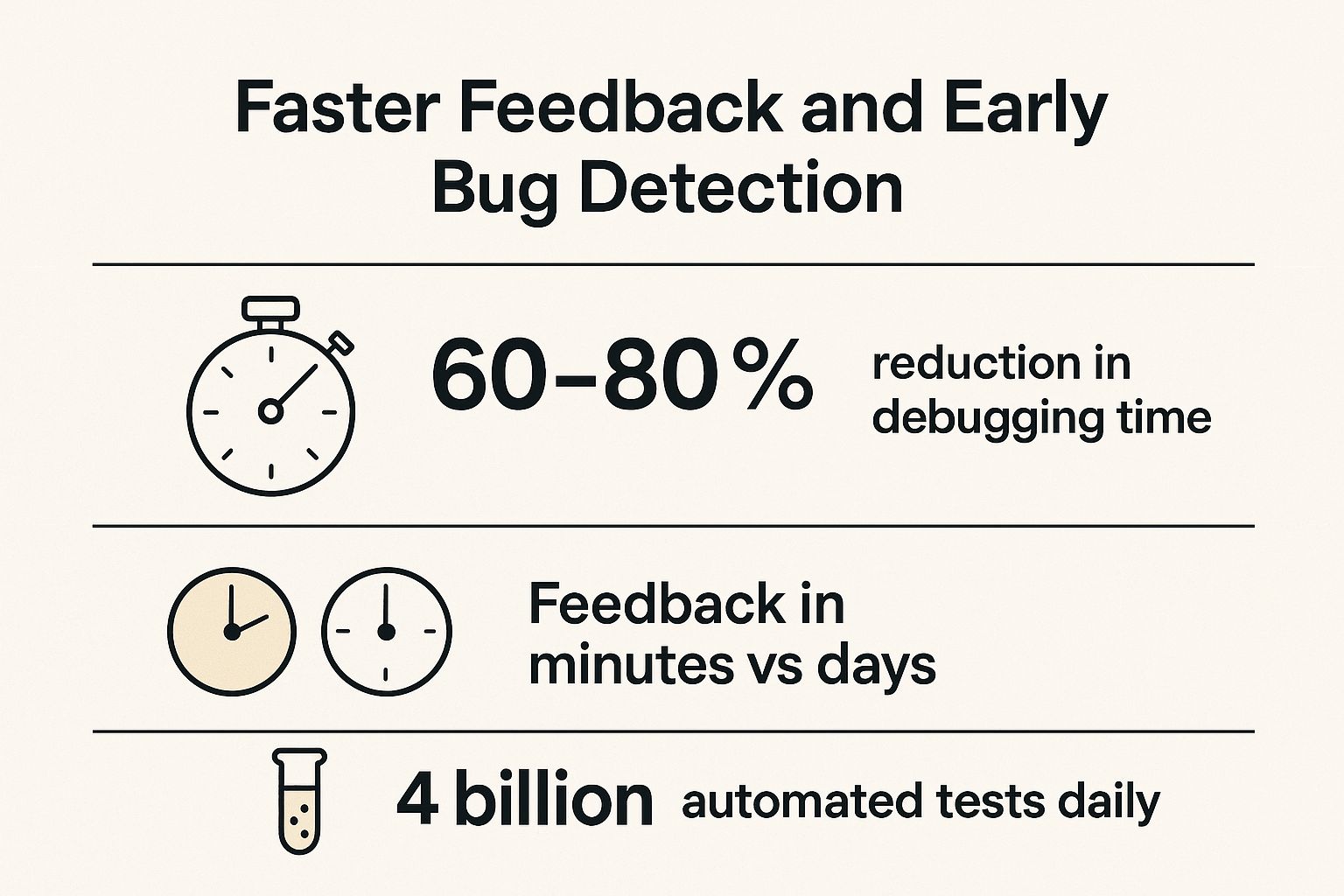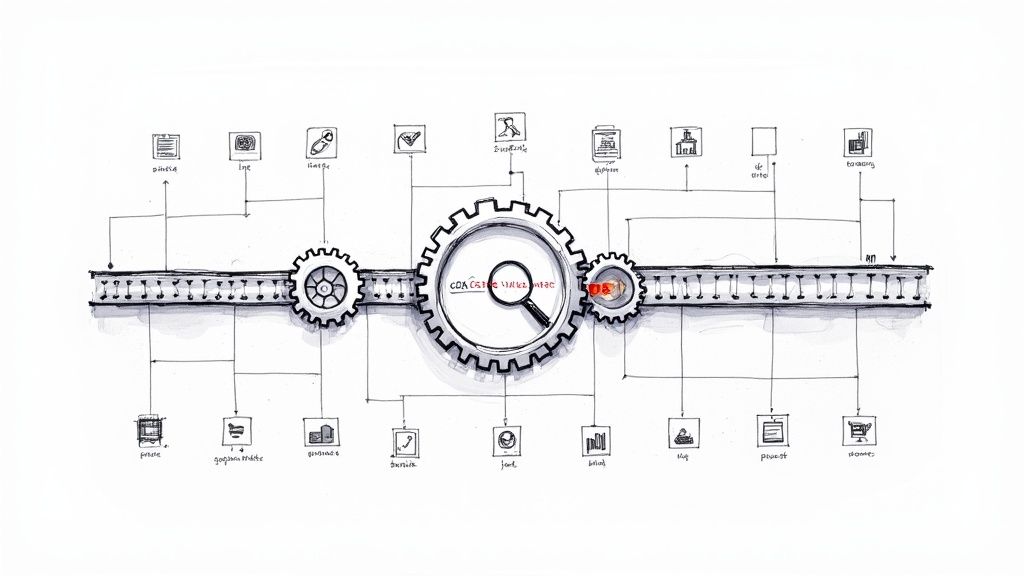Benefits of Continuous Integration: Boost Your Development

Embracing the Power of Continuous Integration
Want to ship better software, faster? This listicle explores six core benefits of continuous integration (CI) and how it improves development workflows. Learn how CI leads to faster feedback, fewer integration problems, higher code quality, quicker releases, better team communication, and reduced deployment failures. Whether you're new to CI or a seasoned pro, understanding these advantages will help optimize your software development process.
1. Faster Feedback and Early Bug Detection
In the fast-paced world of software development, speed and quality are paramount. Continuous Integration (CI) offers a powerful solution to accelerate development cycles while simultaneously enhancing the quality of the final product. One of the most significant benefits of CI is its ability to provide faster feedback and enable early bug detection, a crucial aspect for any successful software project. This rapid feedback loop is a cornerstone of modern software development, enabling teams to identify and address issues quickly, efficiently, and cost-effectively.
Continuous Integration works by automatically integrating code changes from multiple developers into a shared repository several times a day. Each integration is then verified by an automated build and automated tests. This process ensures that any integration errors or bugs are caught almost immediately after they are introduced, preventing them from propagating further into the development cycle. By catching issues early, CI drastically reduces the time and effort required for debugging and remediation. Instead of spending days or weeks tracking down elusive bugs embedded deep within the codebase, developers can address them while the context and code are still fresh in their minds.
Features that facilitate this rapid feedback loop include automated test execution triggered by every code commit, immediate notifications of build failures, seamless integration with version control systems like Git, comprehensive test coverage reporting, and parallel test execution to minimize feedback time. These automated processes eliminate the need for manual interventions, ensuring a consistent and reliable feedback mechanism.
The advantages of early bug detection are substantial. Bugs discovered early in the development cycle are significantly cheaper and easier to fix. Studies show that debugging time can be reduced by 60-80% by implementing CI. This efficiency boost not only saves valuable development time but also prevents the accumulation of technical debt, which can cripple a project in the long run. Early bug detection inherently contributes to a higher overall code quality, leading to a more stable and reliable software product.
However, implementing CI isn't without its initial challenges. Setting up a comprehensive test suite can be time-consuming, and the initial configuration of the CI pipeline might require some effort. Furthermore, if the tests themselves are slow or inefficient, the development process might experience some initial slowdown. These challenges, though, are typically outweighed by the long-term benefits of CI.
The effectiveness of CI and its impact on early bug detection is demonstrated by industry giants like Google, Netflix, and Spotify. Google runs over 4 billion automated tests daily across their massive codebase, catching regressions and integration issues before they impact users. Netflix uses automated CI pipelines to detect performance regressions within hours, ensuring a seamless streaming experience for millions of subscribers. Spotify, with its complex microservices architecture, leverages CI to identify integration issues immediately across over 100 individual services. These examples showcase the power of CI in maintaining code quality and accelerating development velocity at scale.
To successfully implement CI for faster feedback and early bug detection, consider these tips: Start with critical path tests first to ensure core functionalities are covered, utilize test parallelization to reduce feedback time, implement fail-fast strategies to quickly identify and halt failing builds, and set up clear notification systems (e.g., email, Slack) to alert developers about build failures promptly.
The concepts underlying continuous integration have been championed and popularized by influential figures in the software development world, including Kent Beck (Extreme Programming), Martin Fowler (ThoughtWorks), and Grady Booch (IBM). Their work has significantly contributed to the widespread adoption of CI as a best practice in modern software development.
The infographic below visualizes key data related to the benefits of faster feedback and early bug detection through continuous integration.

The infographic highlights the dramatic impact of CI, showcasing a 60-80% reduction in debugging time, near-instant feedback measured in minutes rather than days, and the impressive scale of automated testing achievable, as demonstrated by Google's 4 billion daily tests. These statistics underscore the power of CI in enabling early bug detection, ultimately leading to significant time savings, cost reductions, and improved software quality.
Continuous integration is essential for any development team seeking to accelerate their development cycle while ensuring high-quality software. The ability to receive faster feedback and detect bugs early allows developers to address issues proactively, minimize technical debt, and ultimately deliver a more robust and reliable product. By embracing CI and investing in a robust testing infrastructure, organizations can gain a competitive edge in today’s demanding software landscape.
2. Reduced Integration Problems
One of the most significant benefits of continuous integration (CI) is the drastic reduction, and often near elimination, of integration problems. Traditional software development often suffered from "integration hell," a painful and time-consuming process where developers struggled to merge large, divergent code branches after working in isolation for extended periods. This often led to a cascade of merge conflicts, broken builds, and unexpected behavior, delaying releases and frustrating development teams. Continuous integration directly addresses this pain point by promoting frequent, automated integration of code changes, typically multiple times a day.
The core principle behind CI's success in reducing integration problems is simple: integrate early and often. Instead of allowing code changes to diverge significantly, CI encourages developers to merge their work into a shared mainline (often called "main" or "trunk") frequently. This practice minimizes the scope of each integration, making it much easier to identify and resolve conflicts when they arise. Small, incremental changes are far less likely to introduce breaking changes than large, complex merges. This approach allows for rapid feedback and early detection of integration issues, preventing them from snowballing into larger, more difficult-to-fix problems down the line.
Several key features enable CI to effectively minimize integration problems:
- Frequent Code Merging: The cornerstone of CI is the practice of merging code multiple times per day. This ensures that changes are integrated regularly, preventing long-lived branches and reducing the likelihood of complex merge conflicts.
- Automated Conflict Detection: CI systems automatically detect merge conflicts, notifying developers immediately so they can be addressed promptly. This prevents conflicts from lingering and becoming more difficult to resolve.
- Branch Management Strategies: Effective branching strategies, such as short-lived feature branches or Gitflow, are crucial for successful CI. These strategies define how developers create and manage branches, promoting organized and efficient code integration.
- Merge Queue Systems: Sophisticated CI systems often incorporate merge queues, which manage the order in which code changes are integrated into the main branch. This helps prevent integration conflicts and ensures that builds remain stable.
- Integration Testing Automation: Automated integration tests are an essential component of CI. These tests are run automatically after each code integration to verify that the changes haven't introduced any regressions or broken existing functionality. This provides immediate feedback on the quality and stability of the integrated code.
The advantages of reducing integration problems through CI are numerous:
- Eliminates 'Big Bang' Integration: CI avoids the dreaded “big bang” integration, where large, disparate code changes are merged at the last minute, often resulting in significant delays and instability.
- Reduces Merge Conflicts: Studies show that CI can reduce merge conflicts by 70-90%, freeing up developers to focus on writing code rather than resolving conflicts.
- Maintains a Stable Main Branch: Frequent integration and automated testing help maintain a stable and reliable main branch, ensuring that the software is always in a releasable state.
- Enables Parallel Development without Friction: CI allows multiple developers to work on different features simultaneously without worrying about integration headaches.
However, implementing CI effectively requires certain considerations:
- Disciplined Development Practices: CI requires developers to adhere to established branching strategies and commit code frequently.
- Feature Flags: For incomplete features, feature flags may be necessary to prevent partially implemented code from breaking the main branch.
- Good Communication: Effective communication between team members is essential to ensure that everyone is aware of ongoing integration efforts.
Many leading tech companies have successfully implemented CI and reaped its benefits:
- Facebook: Facebook's continuous deployment system handles over 1,000 commits daily, demonstrating the scalability and effectiveness of CI at a massive scale.
- Amazon: Amazon integrates code changes every 11.7 seconds on average, showcasing the extreme end of continuous integration and its impact on rapid delivery.
- Microsoft: Microsoft adopted CI to significantly reduce integration time from weeks to hours for Windows development, highlighting the efficiency gains possible with CI.
To effectively reduce integration problems with CI, consider the following tips:
- Keep Commits Small and Focused: Smaller, more frequent commits make it easier to identify and resolve conflicts.
- Use Feature Flags for Work-in-Progress Features: Feature flags allow you to integrate incomplete features without breaking the main branch.
- Implement Automated Merge Conflict Resolution: Where possible, automate the resolution of simple merge conflicts.
- Establish Clear Branching Strategies: Define and communicate clear branching strategies to ensure consistent and efficient code integration.
The concepts and practices of Continuous Integration, and its impact on reducing integration problems, have been popularized by industry leaders such as Kent Beck, Jez Humble (co-author of Continuous Delivery), and Dave Farley (co-author of Continuous Delivery). Their work has helped to establish CI as a cornerstone of modern software development. By embracing CI, development teams can significantly reduce integration headaches, accelerate development cycles, and deliver higher-quality software.
3. Improved Code Quality and Standards
One of the most significant benefits of continuous integration (CI) is its profound impact on code quality and the enforcement of coding standards. CI pipelines, by their very nature, promote a culture of quality-first development by automating the process of code analysis, style checking, security scanning, and quality gate enforcement. Every commit triggers these automated checks, ensuring that code adheres to predefined standards before it's merged into the main branch. This proactive approach prevents the accumulation of technical debt and promotes a more maintainable and robust codebase.

This automated quality control mechanism works by integrating various tools into the CI pipeline. Automated code linters and formatters, such as ESLint and Prettier for JavaScript, ensure consistent code style across the entire project. Static code analysis tools delve deeper, identifying potential code smells, logic errors, and vulnerabilities before they manifest into runtime issues. Security vulnerability scanners, integrated into the CI process, automatically detect known security flaws in the codebase or its dependencies. Furthermore, code coverage measurement tools track the percentage of code covered by tests, providing valuable insights into the thoroughness of the testing process. Finally, quality gates act as checkpoints within the pipeline, preventing code from progressing to further stages if it fails to meet specified criteria.
The advantages of this rigorous approach to code quality are numerous. Consistent code style across the team improves readability and makes it easier for developers to collaborate and understand each other's work. Automated detection of code smells and vulnerabilities prevents these issues from making their way into production, reducing the risk of bugs, security breaches, and costly rework. Improved maintainability and readability are direct consequences of adhering to consistent standards, making it easier to update, modify, and debug the codebase in the long run. This proactive approach significantly reduces the accumulation of technical debt, which can otherwise cripple a project over time.
Several real-world examples illustrate the power of CI in enhancing code quality. LinkedIn reported a 40% improvement in code quality after implementing comprehensive CI quality gates. Airbnb leverages ESLint and Prettier in their CI pipeline to maintain a consistent JavaScript code style across their vast codebase. Shopify achieved a remarkable 85% reduction in security vulnerabilities by integrating automated security scanning into their CI workflow. These examples demonstrate the tangible benefits that organizations can realize by embracing CI for code quality improvement. You can Learn more about Improved Code Quality and Standards.
However, implementing these quality checks isn't without its challenges. The initial setup of quality tools can be complex and require significant configuration effort. Integrating these tools into the CI pipeline might initially slow down development speed as developers adapt to the new processes and address flagged issues. Automated tools can sometimes generate false positives, requiring manual review and potentially creating unnecessary overhead.
To effectively leverage CI for improved code quality, consider the following tips. Start with basic linting rules and gradually add more complex checks as your team matures. Tools like SonarQube provide comprehensive code analysis capabilities and can be invaluable for identifying a wide range of code quality issues. Implement incremental quality checks to avoid overwhelming developers with a sudden influx of feedback. Provide clear documentation on quality standards and ensure that the team understands the rationale behind the chosen rules.
Implementing CI for improved code quality and standards is essential for any software development team aiming for long-term success. This approach not only elevates the quality of the codebase but also fosters a culture of quality-first development, leading to more robust, maintainable, and secure software. This aspect of CI is especially beneficial for software development teams, DevOps engineers, quality assurance professionals, IT leaders, tech startups, CI/CD engineers, and platform engineers striving for excellence and efficiency in their software development lifecycle.
4. Faster Time to Market
One of the most compelling benefits of continuous integration (CI) is its ability to drastically accelerate the software delivery lifecycle, leading to a faster time to market. In today's dynamic and competitive landscape, being able to quickly respond to market demands and customer feedback is paramount. CI achieves this by automating key processes within the software development pipeline, enabling faster feature delivery and a significant reduction in the time it takes to deploy code changes from commit to production. This agility is crucial for businesses seeking to maintain a competitive edge and rapidly innovate.

At the heart of CI's speed boost lies the automation of build, test, and deployment processes. Traditionally, these steps were often manual and error-prone, creating bottlenecks in the delivery pipeline. With CI, developers commit code changes frequently to a shared repository, triggering automated builds and a series of predefined tests. This automation not only ensures consistent quality but also eliminates the delays associated with manual intervention. Features like parallel processing of CI tasks further optimize the pipeline, allowing multiple tests to run concurrently and significantly reducing overall execution time.
Automated environment provisioning is another key component contributing to faster time to market. CI systems can automatically create and configure the necessary infrastructure for testing and deployment, eliminating the time and effort required for manual setup. This ensures that the software is consistently tested in a representative environment, minimizing the risk of deployment issues. Furthermore, release automation and rollback capabilities allow for swift and controlled deployments, with the ability to quickly revert to a previous stable version if needed. Integration with various deployment platforms streamlines the deployment process, enabling seamless delivery to different environments, including cloud, on-premise, and hybrid infrastructures.
The advantages of this accelerated delivery are manifold. It reduces deployment time from hours or even days to mere minutes, allowing organizations to respond rapidly to market changes and gain a competitive edge. This rapid response capability empowers businesses to seize opportunities, address emerging threats, and quickly iterate on product features based on real-time feedback. Moreover, CI enhances developer productivity by automating tedious tasks and providing immediate feedback on code changes. This frees up developers to focus on what they do best: building innovative software. It also facilitates rapid experimentation and A/B testing, enabling data-driven decision-making and optimized product development.
While the benefits are clear, implementing CI effectively does require an upfront investment in automation infrastructure and processes. Complex applications may have longer pipeline times initially, and a reliable CI infrastructure is crucial for smooth operation. Learn more about Faster Time to Market to understand the nuances of successful implementation. Organizations that have successfully adopted CI have reaped substantial rewards. Etsy, renowned for its rapid deployment cycle, deploys to production over 50 times per day using automated CI/CD pipelines. Netflix, another champion of CI/CD, reduced its deployment time from 45 minutes to just 5 minutes. Similarly, Uber decreased time-to-market for new features by an impressive 60% after implementing CI.
To optimize your CI pipeline for maximum speed and efficiency, consider these practical tips: optimize build times through caching and parallelization; utilize containerization technologies like Docker for consistent and reproducible environments; implement blue-green deployments for zero-downtime releases; and continuously monitor pipeline performance to identify and address bottlenecks. The impact of CI/CD and its core principles, popularized by figures like Jez Humble and Dave Farley (Continuous Delivery), Gene Kim (DevOps movement), and the Netflix Engineering Team, has revolutionized software delivery, and faster time to market stands as a testament to its effectiveness. By embracing CI, organizations can transform their development processes, enabling them to deliver high-quality software faster and more efficiently than ever before.
5. Enhanced Team Collaboration and Communication
One of the most significant benefits of continuous integration (CI) lies in its ability to foster a culture of enhanced team collaboration and communication. CI, by its very nature, creates a shared, transparent development environment where every team member has clear visibility into code changes, build status, and the overall health of the project. This shared understanding is crucial for breaking down silos, improving knowledge sharing, and promoting a sense of collective code ownership, ultimately leading to higher quality software and faster delivery cycles. This is a key reason why CI deserves a prominent place in the list of benefits.
At the heart of CI's collaborative power is the shared repository and the automated build process. Each code commit triggers a build, the results of which are immediately visible to the entire team. This transparency eliminates the guesswork around integration issues and allows for rapid feedback and quicker resolution of conflicts. Instead of discovering integration problems late in the development cycle, CI surfaces them early, when they are less costly and complex to fix.
Several key features contribute to this enhanced collaboration:
- Shared build status dashboards: These dashboards provide a centralized view of the build pipeline, showing the status of each build, any failed tests, and the overall project health. This at-a-glance view keeps everyone on the same page and promotes open communication about potential problems.
- Automated notifications and alerts: CI systems can be configured to send automated notifications (e.g., via email, Slack, Microsoft Teams) to team members about build failures, successful deployments, or other important events. This keeps the team informed in real-time and allows for immediate action when necessary.
- Code review integration: CI often integrates seamlessly with code review platforms, linking build results directly to specific code changes. This makes it easier for reviewers to assess the impact of changes and identify potential issues before they are merged into the main branch.
- Team-wide visibility into changes: Every code commit, along with its associated build results, is documented and readily accessible to the entire team. This promotes transparency and accountability, as everyone can see who made what changes and when.
- Collaborative debugging tools: The shared environment fostered by CI facilitates collaborative debugging. When a build fails, the entire team can access the relevant information and work together to identify and fix the issue.
The pros of this collaborative approach are numerous:
- Improved transparency across the development team: Everyone is aware of the current state of the project, reducing uncertainty and fostering trust.
- Better knowledge sharing and code ownership: Team members become more familiar with different parts of the codebase, promoting collective ownership and reducing reliance on individual "experts."
- Reduced silos between developers: CI encourages communication and collaboration, breaking down traditional barriers between developers and fostering a more unified team.
- Enhanced accountability for code quality: The transparent nature of CI makes it easier to identify the source of bugs and encourages developers to take ownership of the quality of their code.
However, there are potential downsides to consider:
- Notification fatigue: If not configured properly, the constant stream of notifications can become overwhelming and lead to developers ignoring important alerts.
- Requires cultural shift toward transparency: CI requires a culture of open communication and shared responsibility, which may be a challenge for some teams.
- Can expose individual performance differences: The transparent nature of CI can highlight differences in developer productivity and code quality, which can be sensitive.
Successful implementations of CI for improved collaboration abound:
- Atlassian's development teams use CI dashboards for daily standups, fostering open discussion around build status and potential roadblocks.
- Slack integrates CI notifications directly into team channels, providing real-time updates and facilitating rapid communication.
- GitLab's merge request workflow combines CI with peer review, ensuring that code changes are thoroughly vetted and integrated smoothly.
To maximize the collaborative benefits of CI, consider the following tips:
- Configure notifications thoughtfully: Avoid spamming team members with unnecessary alerts. Focus on critical events and customize notification settings based on individual preferences.
- Use information radiators and dashboards effectively: Display key metrics and build status prominently to keep the team informed at a glance.
- Implement pair programming with CI integration: Pair programming combined with CI provides real-time feedback and promotes knowledge sharing.
- Create team rituals around build success/failure: Celebrate successful builds and conduct post-mortems for failures to learn from mistakes and improve processes.
By thoughtfully implementing CI and embracing its collaborative potential, development teams can significantly improve their communication, accelerate their development cycles, and deliver higher quality software. The practices popularized by organizations like Atlassian, GitHub (through Pull Requests and Actions), and ThoughtWorks consulting demonstrate the transformative power of CI in fostering a more collaborative and efficient development environment.
6. Better Risk Management and Reduced Deployment Failures
One of the most compelling benefits of continuous integration (CI) is its profound impact on risk management and the drastic reduction in deployment failures it facilitates. In today's fast-paced software development landscape, releasing buggy code can have severe consequences, from financial losses and reputational damage to frustrated users and lost market share. CI offers a powerful antidote to these risks by shifting the focus from reactive bug fixing to proactive prevention. By catching issues early in the development cycle and providing consistent, repeatable deployment processes, CI helps create more stable releases and minimizes the business impact of software defects. This makes it a critical component for any team aiming for high-quality software and efficient delivery pipelines.
At its core, CI works by frequently integrating code changes into a shared repository. Each integration triggers an automated build and testing process, ensuring that new code doesn't introduce regressions or break existing functionality. This constant feedback loop allows developers to identify and address issues immediately, preventing them from snowballing into larger, more complex problems down the line. Imagine a scenario where a developer introduces a bug that impacts a critical user flow. Without CI, this bug might remain undetected until much later in the development cycle, potentially even making it into production. With CI, however, automated tests would immediately flag the issue, allowing the developer to fix it before it impacts other parts of the system.
This proactive approach to quality assurance is supported by several key features within a CI pipeline. Automated regression testing ensures that new code doesn't break existing features. Environment consistency validation ensures that the application behaves as expected across different environments, from development and staging to production. Deployment simulation and testing allow teams to rehearse deployments in a safe environment, identifying potential issues before they impact real users. Moreover, automated rollback capabilities provide a safety net in case something does go wrong during deployment, enabling swift recovery and minimizing downtime. Sophisticated CI systems also incorporate risk assessment and reporting features, providing insights into potential vulnerabilities and helping teams prioritize remediation efforts. Learn more about Better Risk Management and Reduced Deployment Failures
The advantages of this approach are substantial. Organizations implementing comprehensive CI pipelines frequently report a significant reduction in production deployment failures, often by as much as 90%. When issues do occur, recovery is much faster thanks to the early detection and rollback capabilities. Furthermore, CI establishes predictable and repeatable release processes, allowing teams to deploy software with confidence and at a higher frequency. The overall result is a reduced business impact from software defects, contributing to improved customer satisfaction, enhanced brand reputation, and a more competitive edge in the market.
However, implementing CI effectively does come with its challenges. It requires investment in a comprehensive testing infrastructure, including robust automated tests and reliable CI/CD tooling. There's also the risk of developing a false sense of security if the tests are inadequate or don't cover all critical scenarios. In complex systems, edge cases may still exist that are not caught by automated tests, requiring vigilance and ongoing monitoring.
Despite these challenges, the benefits of CI far outweigh the potential drawbacks. Real-world examples abound, showcasing the transformative power of CI in reducing deployment failures and improving software quality. Capital One, for example, reported a 75% reduction in production incidents after implementing a comprehensive CI strategy. Target successfully eliminated major deployment failures during high-traffic periods like Black Friday using CI/CD. Booking.com, with its high-volume transaction processing, relies on CI to safely deploy code over 1000 times a day.
To maximize the benefits of CI for risk management, consider the following tips: Implement comprehensive smoke tests for production deployments to quickly identify critical issues. Utilize canary deployments and feature flags for gradual rollouts, allowing you to test new features in production with a small subset of users before releasing them to everyone. Monitor key business metrics during and after deployments to detect any anomalies. Finally, maintain detailed deployment logs and audit trails for troubleshooting and analysis.
The principles and practices of CI, championed by organizations like Google with their Site Reliability Engineering (SRE) practices, the Netflix Chaos Engineering team, and Amazon Web Services DevOps practices, have revolutionized how software is developed and deployed. By prioritizing early detection, automated testing, and consistent deployment processes, continuous integration empowers teams to mitigate risk, reduce deployment failures, and deliver high-quality software that meets the demands of today's dynamic business environment.
Key Benefits of Continuous Integration Comparison
| Benefit | 🔄 Implementation Complexity | 🛠️ Resource Requirements | 📊 Expected Outcomes | 💡 Ideal Use Cases | ⭐ Key Advantages |
|---|---|---|---|---|---|
| Faster Feedback and Early Bug Detection | Medium – requires comprehensive test setup and automation | High – test suite, automation tools, parallel execution | Rapid bug detection, 60–80% less debugging time | Teams focusing on quality and quick feedback cycles | Immediate feedback, reduced technical debt, improved code quality |
| Reduced Integration Problems | Medium – disciplined workflows and branching strategies required | Medium – automation for merges and conflict detection | Stable main branch, 70–90% fewer merge conflicts | Large teams with parallel feature development | Eliminates integration bottlenecks, smoother merges |
| Improved Code Quality and Standards | Medium to High – setup of multiple analysis and scanning tools | Medium to High – code quality tools, static analysis | Consistent standards, reduced vulnerabilities | Organizations focused on maintainable, secure code | Automated quality gates, reduced technical debt, security enhancement |
| Faster Time to Market | High – automation of build, test, and deployment pipelines | High – CI/CD infrastructure and deployment automation | Shorter deployment time, rapid feature delivery | Companies needing fast release cycles and frequent deployments | Accelerated delivery, increased productivity, rapid experimentation |
| Enhanced Team Collaboration and Communication | Low to Medium – setup of dashboards and notifications | Low to Medium – collaboration tools integration | Better transparency, knowledge sharing | Teams aiming for improved communication and shared ownership | Increased accountability, reduced silos, improved coordination |
| Better Risk Management and Reduced Deployment Failures | Medium to High – requires robust testing and deployment automation | High – testing infrastructure and monitoring | 90% fewer deployment failures, more stable releases | Mission-critical systems requiring high reliability | Reduced business impact, predictable releases, faster issue recovery |
Harnessing the Full Potential of CI
The benefits of continuous integration are multifaceted and transformative for software development teams. From faster feedback loops and early bug detection to improved code quality and enhanced team collaboration, CI empowers organizations to deliver high-quality software at speed. By reducing integration problems and mitigating deployment failures, CI paves the way for faster time to market and better risk management. Protecting your valuable data is a crucial aspect of any development process. Implementing robust security measures for your code, backups, and other essential files should be a top priority. For insights on safeguarding your data, explore these secure storage solutions highlighted in "Top Secure Storage Solutions for 2025 | Protect Your Data from Endless Storage". Mastering these core benefits of continuous integration not only optimizes your development pipeline but also fosters a culture of continuous improvement, leading to greater efficiency and sustainable success in the ever-evolving landscape of software development.
Taking your CI process to the next level requires powerful automation and workflow optimization. Streamline your merges, automate your workflows, and unlock the full potential of your CI pipeline with Mergify. Start optimizing your CI/CD workflows today and experience the difference Mergify can make.





